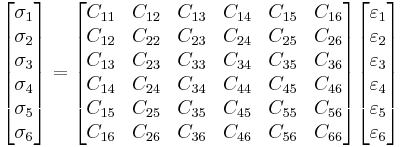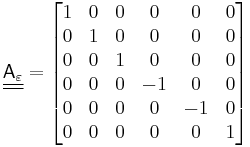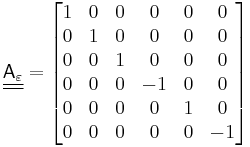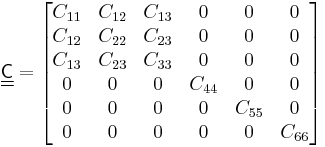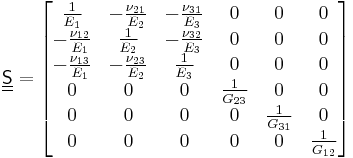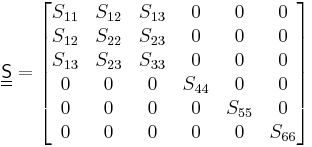Orthotropic material
An orthotropic material has two or three mutually orthogonal twofold axes of rotational symmetry so that its mechanical properties are, in general, different along each axis. Orthotropic materials are thus anisotropic; their properties depend on the direction in which they are measured. An isotropic material, in contrast, has the same properties in every direction.
One common example of an orthotropic material with two axis of symmetry would be a polymer reinforced by parallel glass or graphite fibers. The strength and stiffness of such a composite material will usually be greater in a direction parallel to the fibers than in the transverse direction. Another example would be a biological membrane, in which the properties in the plane of the membrane will be different from those in the perpendicular direction. Such materials are sometimes called transverse isotropic.
A familiar example of an orthotropic material with three mutually perpendicular axis is wood, in which the properties (such as strength and stiffness) along its grain and in each of the two perpendicular directions are different. Hankinson's equation provides a means to quantify the difference in strength in different directions. Another example is a metal which has been rolled to form a sheet; the properties in the rolling direction and each of the two transverse directions will be different due to the anisotropic structure that develops during rolling.
It is important to keep in mind that a material which is anisotropic on one length scale may be isotropic on another (usually larger) length scale. For instance, most metals are polycrystalline with very small grains. Each of the individual grains may be anisotropic, but if the material as a whole comprises many randomly oriented grains, then its measured mechanical properties will be an average of the properties over all possible orientations of the individual grains.
Contents |
Orthotropy in physics
Anisotropic material relations
Material behavior is represented in physical theories by constitutive relations. A large class of physical behaviors can be represented by linear material models that take the form of a second-order tensor. The material tensor provides a relation between two vectors and can be written as
where  are two vectors representing physical quantities and
are two vectors representing physical quantities and  is the second-order material tensor. If we express the above equation in terms of components with respect to an orthonormal coordinate system, we can write
is the second-order material tensor. If we express the above equation in terms of components with respect to an orthonormal coordinate system, we can write
Summation over repeated indices has been assumed in the above relation. In matrix form we have
Examples of physical problems that fit the above template are listed in the table below[1].
Condition for material symmetry
The material matrix  has a symmetry with respect to a given orthogonal transformation (
has a symmetry with respect to a given orthogonal transformation ( ) if it does not change when subjected to that transformation. For invariance of the material properties under such a transformation we require
) if it does not change when subjected to that transformation. For invariance of the material properties under such a transformation we require
Hence the condition for material symmetry is (using the definition of an orthogonal transformation)
Orthogonal transformations can be represented in Cartesian coordinates by a  matrix
matrix  given by
given by
Therefore the symmetry condition can be written in matrix form as
Orthotropic material properties
An orthotropic material has three orthogonal symmetry planes. If we choose an orthonormal coordinate system such that the axes coincide with the normals to the three symmetry planes, the transformation matrices are
It can be shown that if the matrix  for a material is invariant under reflection about two orthogonal planes then it is also invariant under reflection about the third orthogonal plane.
for a material is invariant under reflection about two orthogonal planes then it is also invariant under reflection about the third orthogonal plane.
Consider the reflection  about the
about the  plane. Then we have
plane. Then we have
The above relation implies that  . Next consider a reflection
. Next consider a reflection  about the
about the  plane. We then have
plane. We then have
That implies that  . Therefore the material properties of an orthotropic material are described by the matrix
. Therefore the material properties of an orthotropic material are described by the matrix
Orthotropy in linear elasticity
Anisotropic elasticity
In linear elasticity, the relation between stress and strain depend on the type of material under consideration. This relation is known as Hooke's law. For anisotropic materials Hooke's law can be written as[2]
where  is the stress tensor,
is the stress tensor,  is the strain tensor, and
is the strain tensor, and  is the elastic stiffness tensor. If the tensors in the above expression are described in terms of components with respect to an orthonormal coordinate system we can write
is the elastic stiffness tensor. If the tensors in the above expression are described in terms of components with respect to an orthonormal coordinate system we can write
where summation has been assumed over repeated indices. Since the stress and strain tensors are symmetric, and since the stress-strain relation in linear elasticity can be derived from a strain energy density function, the following symmetries hold for linear elastic materials
Because of the above symmetries, the stress-strain relation for linear elastic materials can be expressed in matrix form as
An alternative representation in Voigt notation is
or
The stiffness matrix  in the above relation satisfies point symmetry [3].
in the above relation satisfies point symmetry [3].
Condition for material symmetry
The stiffness matrix  satisfies a given symmetry condition if it does not change when subjected to the corresponding orthogonal transformation. The orthogonal transformation may represent symmetry with respect to a point, an axis, or a plane. Orthogonal transformations in linear elasticity include rotations and reflections, but not shape changing transformations and can be represented, in orthonormal coordinates, by a
satisfies a given symmetry condition if it does not change when subjected to the corresponding orthogonal transformation. The orthogonal transformation may represent symmetry with respect to a point, an axis, or a plane. Orthogonal transformations in linear elasticity include rotations and reflections, but not shape changing transformations and can be represented, in orthonormal coordinates, by a  matrix
matrix  given by
given by
In Voigt notation, the transformation matrix for the stress tensor can be expressed as a  matrix
matrix  given by[3]
given by[3]
The transformation for the strain tensor has a slightly different form because of the choice of notation. This transformation matrix is
It can be shown that  .
.
The elastic properties of a continuum are invariant under an orthogonal transformation
if and only if[3]
Stiffness and compliance matrices in orthotropic elasticity
An orthotropic elastic material has three orthogonal symmetry planes. If we choose an orthonormal coordinate system such that the axes coincide with the normals to the three symmetry planes, the transformation matrices are
We can show that if the matrix  for a linear elastic material is invariant under reflection about two orthogonal planes then it is also invariant under reflection about the third orthogonal plane.
for a linear elastic material is invariant under reflection about two orthogonal planes then it is also invariant under reflection about the third orthogonal plane.
If we consider the reflection  about the
about the  plane, then we have
plane, then we have
Then the requirement  implies that[3]
implies that[3]
The above requirement can be satisfied only if
Let us next consider the reflection  about the
about the  plane. In that case
plane. In that case
Using the invariance condition again, we get the additional requirement that
No further information can be obtained because the reflection about third symmetry plane is not independent of reflections about the planes that we have already considered. Therefore, the stiffness matrix of an orthotropic linear elastic material can be written as
The inverse of this matrix is commonly written as[4]
where  is the Young's modulus along axis
is the Young's modulus along axis  ,
,  is the shear modulus in direction
is the shear modulus in direction  on the plane whose normal is in direction
on the plane whose normal is in direction  , and
, and  is the Poisson's ratio that corresponds to a contraction in direction
is the Poisson's ratio that corresponds to a contraction in direction  when an extension is applied in direction
when an extension is applied in direction  .
.
Bounds on the moduli of orthotropic elastic materials
The strain-stress relation for orthotropic linear elastic materials can be written in Voigt notation as
where the compliance matrix  is given by
is given by
The compliance matrix is symmetric and must be positive definite for the strain energy density to be positive. This implies from Sylvester's criterion that all the principal minors of the matrix are positive[5], i.e.,
where  is the
is the  principal submatrix of
principal submatrix of  .
.
Then,
We can show that this set of conditions implies that[6]
or
However, no similar lower bounds can be placed on the values of the Poisson's ratios  [5].
[5].
See also
References
- ^ Milton, G. W., 2002, The Theory of Composites, Cambridge University Press.
- ^ Lekhnitskii, S. G., 1963, Theory of Elasticity of an Anisotropic Elastic Body, Holden-Day Inc.
- ^ a b c d Slawinski, M. A., 2010, Waves and Rays in Elastic Continua: 2nd Ed., World Scientific. http://samizdat.mines.edu/wavesandrays/WavesAndRays.pdf
- ^ Boresi, A. P, Schmidt, R. J. and Sidebottom, O. M., 1993, Advanced Mechanics of Materials, Wiley.
- ^ a b Ting, T. C. T. and Chen, T., 2005, Poisson's ratio for anisotropic elastic materials can have no bounds,, Q. J. Mech. Appl. Math., 58(1), pp. 73-82.
- ^ Ting, T. C. T., 1996, Positive definiteness of anisotropic elastic constants,, Mathematics and Mechanics of Solids, 1, pp. 301-314.
Further reading
- Orthotropy modeling equations from OOFEM Matlib manual section.
- Hooke's law for orthotropic materials






























